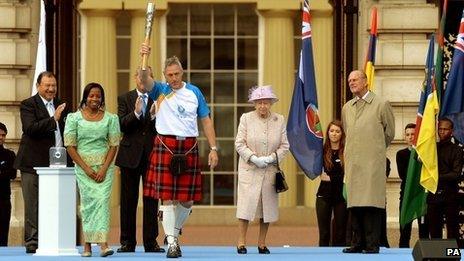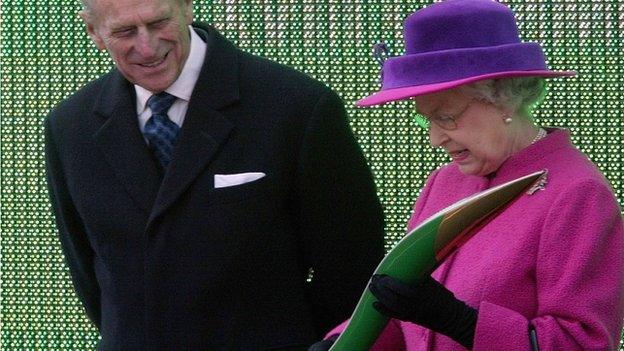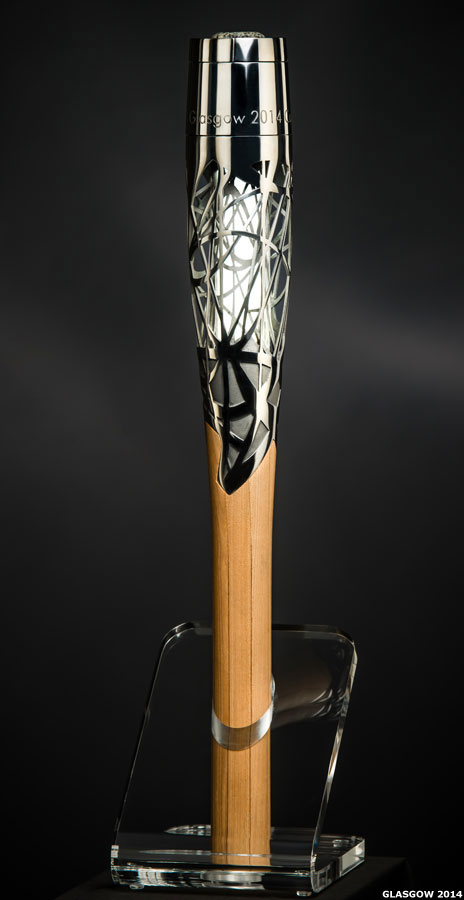Glasgow 2014: Queen launches Commonwealth Games baton relay
- Published
The Queen inserted her message into the baton during a ceremony at Buckingham Palace
The Queen's Baton Relay - heralding the 2014 Commonwealth Games in Glasgow - has been launched at Buckingham Palace.
The baton contains the Queen's hand-written message to the Commonwealth and will visit all 70 competing nations and territories over the next 288 days.
It will travel to Scotland on Thursday before heading to India for its first international stopover on 11 October.
The baton's journey will end at the opening ceremony on 23 July 2014, when the Queen will read the message inside.
The empty baton was escorted to Buckingham Palace by pipers and cyclist Sir Chris Hoy, a six-time Olympic Gold and double Commonwealth Gold medallist.
During the launch ceremony, the President of the Commonwealth Games Federation, Prince Imran of Malaysia, said the relay had power and meaning.
The Story of the Commonwealth Queen's Baton
"The relay unites two billion citizens of the Commonwealth in a celebration of sport, diversity and peace," he said.
"It will also bring the 70 nations and territories of the Commonwealth together.
"Every time the baton is passed it will cement the Commonwealth friendship and reinforce the ways in which we are connected."
The ceremony also heard from Lord Smith of Kelvin, chairman of games organiser Glasgow 2014.
He said: "The spirit of friendship that will be displayed as the baton is passed from hand to hand reflects the warm welcome that nations and territories of the Commonwealth can expect when they come to Glasgow and to Scotland next summer.
"This is a historic moment for Glasgow 2014. We will treasure it and we look forward to following closely the Queen's baton relay on its momentous journey."
Following the speeches, the Queen placed the hand-written scroll, which contains her message to the Commonwealth, inside the baton.
It was then sealed for its journey of more than 190,000km through Commonwealth territories in Asia, Oceania, Africa, North and South America and the Caribbean.
The first baton bearer was Alan Wells, the Scottish sprinter who won gold in the men's 100m at the 1980 Moscow Olympic Games.

The first bearer Alan Wells carries the baton from Buckingham Palace
He said: "As the final runner of the Queen's Baton Relay (QBR) at the last Commonwealth Games on Scottish soil in Edinburgh in 1986, the baton and what it symbolises is incredibly special for me.
"It is a real honour for me to now be named as the first baton-bearer for the Glasgow 2014 Commonwealth Games."
Wells handed the baton on to Scottish swimmer Caitlin McLatchey, who won two gold medals at the 2006 Melbourne Commonwealth Games.
A short relay then took place up and down The Mall involving Scottish athletes Cara Kennedy (artistic gymnast), Morgan McKinnon (triple jump) and Ruairi Kirkwood (swimming).
Other participants included Izzy Conway, a volunteer or Clydesider at the games, Aamir Meymood, the 13-year-old Shawlands Academy pupil who designed the Glasgow 2014 tartan, games ambassador Julie McIlroy and 12-year-old Beth Gilmour, who will be accompanied by games mascot Clyde, whom she designed.
Those attending the ceremony included Scotland's First Minister Alex Salmond.
'Momentous year'
He said: "The start of the Queen's Baton Relay, with two of Scotland's greatest-ever athletes, is another step towards what will be a momentous year for Scotland.
"2014 promises the greatest-ever Games and the relay will provide a fantastic celebration of sport and culture across the Commonwealth, with Glasgow and Scotland at its heart."
During its international journey the baton will spend an average of one to four days in each nation, with an extended duration of seven days in Wales, two weeks in England and 40 days in Scotland.
It will not stopover in the Gambia, which last week withdrew from the Commonwealth, saying it will "never be a member of any neo-colonial institution".
The baton has a lattice design, made from layers of titanium fused together by laser, which means the message is visible.
The designers said the message from the Queen was "pivotal" and they were keen it should not be "hidden away".
The parchment, handmade in Glasgow using linen and plant fibre, is also "dramatically" illuminated by LED lights within a transparent cylinder to make the sealed scroll easier to see.
The brief for designers stated that the baton should be easily handed from person to person, should weigh no more than 2kg and must be able to withstand all weathers for the 10-month relay.
The baton's handle is made of elm wood sourced from the grounds of Garrison House on the Isle of Cumbrae and was constructed using a boatbuilding technique called bird-mouthing, which means it is light, strong and durable.
The top of the baton contains a granite "gemstone" which will be detached by opening a puzzle mechanism and given as gift to each nation and territory.
The gems are made of water-resistant granite unique to Scotland and were sourced from Ailsa Craig in the Firth of Clyde.
Glasgow 2014 will be the 20th Commonwealth Games and will feature 17 sports in 11 days of competition, with 261 medal events.
At the top of the baton is a granite ‘gemstone’, which will be given to each nation and territory. The stones come from Ailsa Craig in the Firth of Clyde and have been crafted by Kays of Scotland and jewellers from Glasgow School of Art.
The gemstone can only be removed by opening a clever puzzle mechanism.
The lattice frame is inspired by Glasgow's industrial and architectural heritage. A process called direct metal laser sintering was used to create its organic shape by fusing together layers of pure titanium powder.
Inside the baton is a message from the Queen, written on parchment handmade in Glasgow from linen and plant fibre. Sealed with the royal seal, the message forms the 'visual core' of the baton, illuminated from within by LED lights.
The elm handle is crafted from wood from the grounds of Garrison House on the Isle of Cumbrae, and represents Scotland's natural resources. It was constructed using a boatbuilding technique known as "bird-mouthing", traditionally used to make ships' masts.
The Commonwealth of Nations has 54 members, but 70 teams participate in the Commonwealth Games because a number of British overseas territories, Crown dependencies and island states compete under their own flag.
The UK nations - Scotland, England, Wales and Northern Ireland - compete separately in the Commonwealth Games, as do the smaller home territories such as Jersey, Guernsey and the Isle of Man.
The first Queen's Baton Relay was staged for the 1958 Commonwealth Games in Cardiff and has been the curtain raiser to the Games ever since.
But until 1998, the relay would only travel through England and the host nation.
By 2002, in Manchester, it was covering 100,000km and visiting 23 nations.
Melbourne 2006 was the first baton relay to visit all the nations which sent teams to the Games.
- Published11 March 2013

